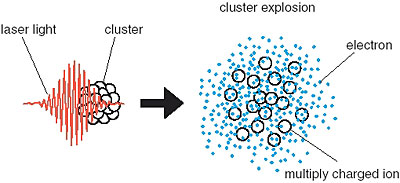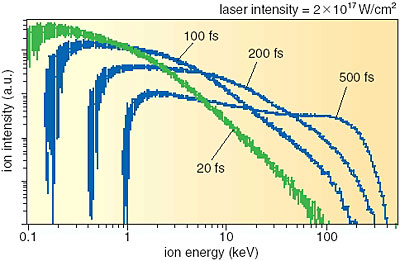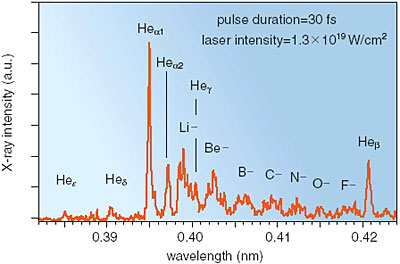By using the JAERI tabletop, high-power Ti:sapphire laser (T cube laser), an extremely high energy of 100 TW (TW=1012 W) can be generated within the very short time duration of 20 fs (fs=10-15 s). This energy corresponds to about thirty times the full electricity production of all electric-power plants around the world.
Because of their unique properties as a target for laser-matter interaction, clusters, aggregates of atoms or molecules, attract the attention of researchers in high-field research. The interaction of intense laser fields with clusters is found to exhibit features distinct from other targets: The cluster media absorb most of the incident laser energy and a cluster explosion occurs (Fig. 5-7). During this process, the absorbed energy is converted to X-ray radiation in the keV range, kinetic energies for electrons and multiply charged ions in the MeV (=106 eV) range. T cube lasers are expected to be utilized as debris free sources of intense X-rays, as ion sources, and even for fusion research. In the past, only a large expensive facility such as a particle accelerator could produce such high-energy particles and X-rays.
Recently, we have succeeded in optimizing the cluster explosion process and have generated multiply charged ions with a mean kinetic energy of 100 keV by manipulating the characteristics of the laser pulse, such as the pulse duration and the signs of the chirp. This energy is about two times larger than that previously obtained (Fig. 5-8). Furthermore, we have succeeded in generating intense X-rays using a huge argon (Ar) cluster (Fig. 5-9). It is found that the estimated intensity (108 photon/pulse, 100 kW) of the Healpha line (3.14 keV) is a light source strong enough for application studies, such as X-ray diffraction measurements.
Improvements in the quality of laser light and particle-code simulations for laser-cluster interactions using a supercomputer are important research tasks for the future. We believe that the combination of these studies will contribute to the realization of the compact laser-based radiation source.
|


